After many years of waiting, the 2nd sealed door inside of a shaft in the Queen’s chamber in the Great Pyramid will be finally opened. A small team from National Geographic along with the Egyptian Antiquities Department and Zahi Hawass are planning on re-attempting to find out exactly what is hidden behind these two small doors. The first door was drilled through a few years ago and it revealed another door blocking the shaft. The researchers will again attempt to drill through this second door and then position a small camera inside to determine what lies behind the blocked shaft.
Is a secret area inside of the Great Pyramid going to be finally revealed after thousands of years of being sealed off? Does a small shaft leading upwards from the Queen’s Chamber contain any big treasures? One thing is certain and that is there are no shortages of legends telling of secret rooms and shafts inside of the Great Pyramid but after years of careful research, most Egyptologists are fairly certain that there are no large areas inside of the pyramid that are still hidden. This is not the case with a shaft leading upwards from the Queen’s Chamber though. The shaft is very small in size and is completely blocked by two small doors with copper handles attached to them. Egyptologists have multiple reasons of what this shaft could have been used for. Among them are ventilation shafts, some kind of astronomical function, or a path for the King’s soul to ascend to the stars and therefore the afterlife. Of course, the real reason could very well not even be among these three possibilities and might never be fully understood.

In 2002, a team led by Zahi Hawass and the Egyptian Antiquities Department along with the National Geographic Channel started a research experiment to explore what lay hidden behind the stone doors inside of the shaft. A robot nicknamed the “pyramid rover” was constructed to make its way up the shaft until it reached the stone door obstructing the rest of the tunnel. At that point, the robot would drill out a small opening on the stone door and place a small camera inside of the hole to see what lay hidden on the other side. On September 17, 2002, on live television throughout the world, the drilling was completed and the camera was inserted to reveal ……….. another stone door. This second door was a complete mystery to all the researchers and Egyptologists and continues to remain a puzzle. There is huge excitement over what may lie hidden behind this second door as one researcher said “It (the 2nd door) is not similar to the first in that it looks as if it is screening or covering something. There were also cracks all over the surface.”

So, what lies hidden behind this second door? Almost every researcher involved with the project is certain that the shaft is not hiding anything of any considerable size due to the dimensions of the shaft itself. Now, this does not mean that there is nothing hidden behind the door either. But whether there will be found something or nothing, all of the researchers involved agree that it will answer questions either way. So, when can we expect the drilling of the second door to start? Most of the team members are aiming for the mid 2011 time period to fully complete the testing and then the actual exploration of the shaft. So, it looks like we only have a few more months wait before a space that has been sealed for thousands of years is finally revealed again.

In 2002, a team led by Zahi Hawass and the Egyptian Antiquities Department along with the National Geographic Channel started a research experiment to explore what lay hidden behind the stone doors inside of the shaft. A robot nicknamed the “pyramid rover” was constructed to make its way up the shaft until it reached the stone door obstructing the rest of the tunnel. At that point, the robot would drill out a small opening on the stone door and place a small camera inside of the hole to see what lay hidden on the other side. On September 17, 2002, on live television throughout the world, the drilling was completed and the camera was inserted to reveal ……….. another stone door. This second door was a complete mystery to all the researchers and Egyptologists and continues to remain a puzzle. There is huge excitement over what may lie hidden behind this second door as one researcher said “It (the 2nd door) is not similar to the first in that it looks as if it is screening or covering something. There were also cracks all over the surface.”

So, what lies hidden behind this second door? Almost every researcher involved with the project is certain that the shaft is not hiding anything of any considerable size due to the dimensions of the shaft itself. Now, this does not mean that there is nothing hidden behind the door either. But whether there will be found something or nothing, all of the researchers involved agree that it will answer questions either way. So, when can we expect the drilling of the second door to start? Most of the team members are aiming for the mid 2011 time period to fully complete the testing and then the actual exploration of the shaft. So, it looks like we only have a few more months wait before a space that has been sealed for thousands of years is finally revealed again.
What Lies at the End of the
Queen's Chamber Shafts?
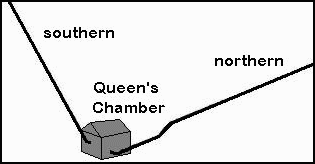
The existence of the so-called "air shafts" in the King's Chamber had been known for a very long time, but the similar shafts of the Queen's Chamber were not discovered until 1872, as they were capped at both ends. Waynman Dixon and his team, investigating a crack in the south wall of the Queen's Chamber, made a cut through the wall that revealed a rectangular channel similar to that found in the King's Chamber. Suspecting a twin shaft on the north wall, another cut was made that confirmed those suspicions. Smoke was released into both shafts, but no exit was indicated.
The explorers: Upuaut 2 (left) and Pyramid Rover (right).
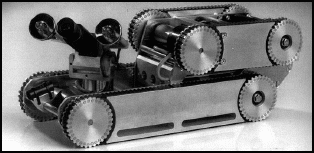
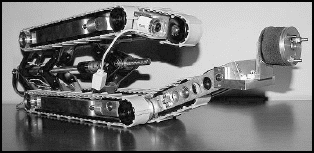
Photo left © copyright Rudolf Gantenbrink 1999; photo right © copyright National Geographic Television and Film


Photo left © copyright Rudolf Gantenbrink 1999; photo right © copyright National Geographic Television and Film
In 1993, German engineer Rudolf Gantenbrink sent a robot of his design, Upuaut-2, up the southern shaft. Gantenbrink recorded what the robot found on 22 March:
At 11.05 a.m., at 59 meters, Upuaut-2 approaches a stone slab, which blocks the shaft! In our video inspection of all four shafts so far, a total of about 180 meters, we have seen only blocks made of local limestone. But the final block before the slab is definitely carved from lighter-colored limestone, probably originating from the Mocatam Mountains about 30 km from the Giza Plateau, on the other side of the Nile. This was the material the builders used for the higher-quality casing stones of the pyramid's exterior, and for the chamber systems. The workmanship of the last block in front of the slab is also much higher than anything we have seen in any of the shafts so far. As we approach the slab, we can see two dark streaks on it, which upon closer inspection turn out to be copper fittings. And there is something else. The face of the inspector sitting next to me at the monitor has become chalk white. He draws my attention to two round, white marks on the copper fittings. "These are seals, these are seals!" he exclaims, visibly shaken. "We must stop work immediately and inform our chairman."A few days later, Gantenbrink attempted a similar survey of the northern shaft, but the attempt was abandoned. "The temptation is great to send Upuaut around the sharp bend at 18 meters," he wrote. "But, since our short guide rods have suddenly turned up missing, the danger is too great that the robot might get stuck and not be able to return."
Subsequently it has come to be known, perhaps unfortunately, as "The Door." This popular name of course implies that the slab actually serves the function of a door, leading to – well, who knows what? But until we can peer behind it, or perhaps even open it, we will never know for sure what it really is and what it meant to the builders of Cheops. So for the time being, it might be more appropriate to refer to it simply as the "USO" – the Unidentified Stone Object.
The end of the shafts: southern (left) and northern (right).
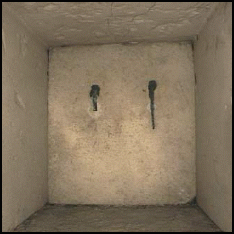
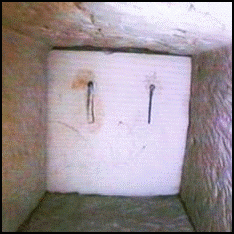
Photo left © copyright Rudolf Gantenbrink 1999; photo right © copyright National Geographic Television and Film


Photo left © copyright Rudolf Gantenbrink 1999; photo right © copyright National Geographic Television and Film
In 2002, another robot, the Pyramid Rover designed by iRobot of Boston, was sent to the end of the southern shaft to investigate further. The robot drilled a 3/4-inch hole in the slab and, on 17 September, a miniature fiber-optic camera was inserted to reveal a rough-hewn blocking stone lying 7 inches beyond the original southern shaft slab. Zahi Hawass, the head of Egypt's Supreme Council of Antiquities, said “There was a space, a void and then what appears to be another ‘door’ which was quite distinct and showed some chisel marks. It looks to me like it is sealing something. It seems that something important is hidden there.”
On 18 September, the Rover was sent up the northern shaft, this time off-the-air. Navigation was difficult due to four sharp bends. Another "stone partition, or door" at the end of the shaft, again with two copper fittings, was discovered. Zahi Hawass said the south shaft's first slab and the slab just discovered in the northern shaft were the same distance (211 feet) from the Queen's Chamber. The robot did not drill through the slab of the northern shaft in its latest probe, but Hawass said that this was in the planning stage.
That the slabs at the end of both shafts act as doors, either practically or symbolically, is debatable, but one cannot argue against the uniqueness of the copper fittings on the slabs. Are they really meant to be handles? And handles or not, what possible purpose might they serve?
Speculation on the two slabs is still in the early stages. Hawass has theorized that they were to serve the ascending soul of the deceased king. Funerary texts, he said, speak of the pharaoh's soul encountering a series of doors before reaching the rewards of afterlife. The late I.E.S. Edwards quipped that a chamber behind the slab might serve as a serdab from which a statue of Khufu would be found to gaze. In his book The Pyramids, Miroslav Verner wrote:
The films [made by Upuaut 2] revealed that the shaft ended with a small limestone slab in which two heavily corroded pieces of copper had been inserted. This discovery led to a series of hypotheses as to what might be hidden behind the slab. One theory suggested that behind the entrance there might be a chamber with a statue of the king. It is unlikely, however, that any space would be accessible through so narrow a shaft. Moreover, the end of the shaft is only about six meters from the outer surface of the pyramid. [p. 200]Mark Lehner simply refers to the slab as a "plugging block with two copper pins." Rainer Stadelmann said, "The door is just a blocking stone; it doesn't block the entrance to something. It simply seals off a corridor." Later he added, "These copper fittings are magical instruments which the king can take, or the soul of the king can take, when it ascends. It uses them to open these blocks and pass through the stones to the sky." That the slabs serve as false doors is possible, as these features are common to Egyptian tombs, but none are known to have been fitted with handles. Zahi Hawass said that because some ancient texts speak of the soul navigating a series of doors guarded by snakes, the brass "handles" on the slabs could represent stylized snakes.
Calling the latest discovery "an exciting thing," Dieter Arnold said, "Don't expect that I can tell you what's behind the stone. We're all stunned. We have no parallel." Stadelmann commented that "It might be possible that there is, let's say, a papyrus or something behind these stones, but there's no place for much more." Kate Spence said she thought the slab was likely a structural blockage that was added to plug the shaft when it was abandoned by the pyramid’s architects. “I suspect it’s been put there to stop rubble falling down the shaft,” she said. John Taylor, assistant keeper of the British Museum's Department of Ancient Egypt and Sudan, said the third "door" may be a dead end, further evidence that the Queen's Chamber was abandoned in favor of the King's Chamber as the actual burial location for Khufu. Dr Aidan Dodson has speculated on what lies beyond the stone behind the slab. He said, "It won't be anything spectacular. My view is that the limestone is damp and cracked and all that is on the other side is the main body of the pyramid."
What lies at the end of the Queen's Chamber shafts? Limestone slabs bearing copper fittings whose purpose remains a mystery. What lies beyond these slabs? Very likely simply the end of the shafts.
| The machine that will do the job |

Upuaut-2 is an original design - only one model exists. All structural parts are milled from aircraft aluminum.
The robot is fitted with a laser guidance system and a SONY CCD miniature video camera with pan and tilt capabilities.
Seven independent electric motors with specially-designed Swiss precision gears drive the upper and lower wheel / track systems, providing leverage thrust of 20 kg and pulling power of 40 kg (under ideal traction conditions).
Power supply is via "umbilical cord", a specially manufactured cable only 4.2 mm in diameter.
The remote control console is microprocessor - controlled.
| Minimum Height Maximum Height Overall Length Overall Width Weight | 120 mm 280 mm 370 mm 120 mm 6 kg |
you can see all the story of the evolution and previous missions of Upuaut 2 just by klicking HERE |
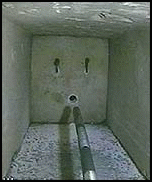
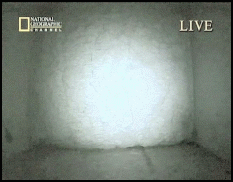
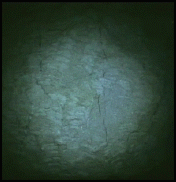

Perhaps the copper plugs were attached to metallic wires or poles with the precise length to transmit EM signals, modulated by a human voice speaking at the resonant frequency to which the chamber is "tuned". A simple receiver elsewhere could reproduce the voice in what might be the first AM radio show . . . "Good morning, Giza!"
ReplyDeleteOMG, the blocks/doors could be used to hold the construction by moving them uppwards each time the next layer was build. thats why it has those copper rings with this loop on that side. and why the shaft was used. possible sunlight?
ReplyDeleteReally? Sunlight? The shaft is way to long, plus, there is a a maze of curves in one, so they would need mirrors to reflect the light, and as far as I know, they didn't find any mirrors in the shaft. So no. It is not for light.
Deletei would be interesting if the camera could look backwards after its through the hole to see if the electrodes come through the other side of the bock as well but i like the em signal idea ... what was the length of the shaft?
ReplyDeleteOh boy do I have some info that I have to once again say so that someone will help me figure out how this could be . Here goes , look at the UNRESTORED version of leonardo davincis last supper and right above who is suppost to be Mary Magdalene is a image of the doorway exactly the white square with the two copper fittings . If you really look close follow what appears to be a shafts right behind Mary magdaline and you'll see a little robot . Really it's mind boggling .also those copper fittings to me look like caching dolls
ReplyDeleteKaahka: Ha ha, this is OLD news, you know. You make it appear like it blew your mind, but it's NOT new, OK? Far from it! It was even in a best seller (crappy though) book.
ReplyDeleteNow, as for the actual subject... How is it that I can't find any fucking information about if they did or not fucking opened these stupid doors!
They PROMISED US to open the 2 doors in 2012! And it was known since 1992! So, well, It's the end of the year 2017 and they fucking RIPPED US OFF! They NEVER opened SHIT!!!
And that is outrageous! I think Egyptian authorities block any attempt from anyone to actually touch this subject anymore!
Isn't it the best proof that there is a cover up there? WHY would they not be interested in this? HOW can anyone justify that it was NEVER done?!
Those are very interesting questions, indeed...